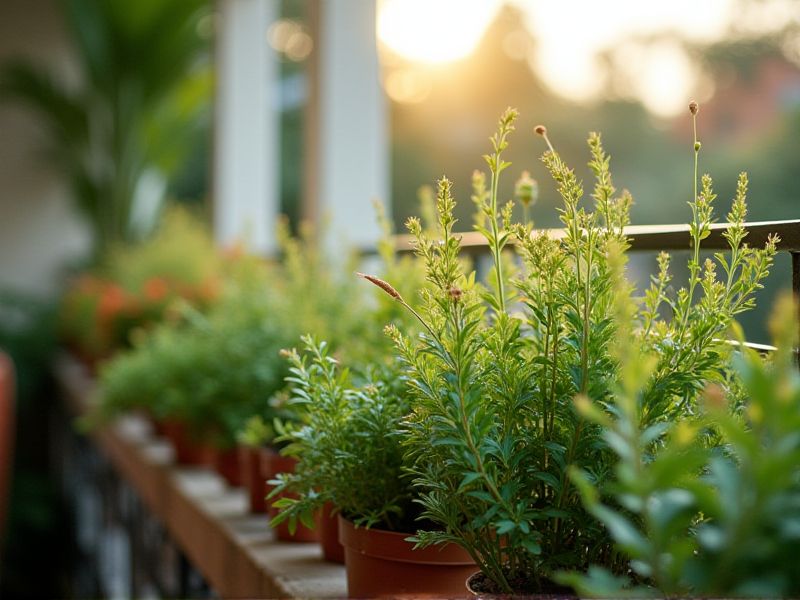
When selecting balcony plants that resist wind, consider sturdy varieties such as ornamental grasses, succulents, and perennial herbs. Lavender, for example, thrives in windy conditions while providing fragrant blooms that attract pollinators. For a touch of greenery, try planting robust shrubs like Boxwood or Juniper, which not only withstand strong gusts but also offer year-round structure. Incorporating windbreaks such as trellises or lattices can further protect your plants, allowing them to flourish in exposed areas. By choosing the right plants and positioning them effectively, you can create a vibrant and resilient balcony garden.
List of some Balcony plants that resist wind
- Lavender (Lavandula)
- Rosemary (Salvia rosmarinus)
- Yucca (Yucca filamentosa)
- Boxwood (Buxus sempervirens)
- Ornamental Grass (Miscanthus sinensis)
- Geranium (Pelargonium)
- Oleander (Nerium oleander)
- Juniper (Juniperus horizontalis)
- Ivy (Hedera helix)
- Dwarf Alberta Spruce (Picea glauca 'Conica')
Important things about Balcony plants that resist wind
Choose Hardy Plant Varieties.
When selecting balcony plants that resist wind, opt for hardy varieties such as Sedum, Lavender, and Ornamental Grasses. These resilient plants, thanks to their sturdy structures and deep root systems, can withstand strong gusts while still providing visual appeal. Incorporate compact shrubs like Boxwood for added greenery that can enhance your balcony's aesthetic. Remember that proper placement and using protective barriers can further shield your plants from harsh weather elements.
Use Lightweight Pots For Stability.
Lightweight pots made from materials like plastic or fiberglass can enhance the stability of your balcony plants, especially in windy conditions. These pots are designed to minimize movement while providing adequate drainage for healthy plant growth. Consider using plants such as lavender, ornamental grasses, or succulents, which are naturally resilient to wind and adverse weather. By selecting the right combination of lightweight containers and wind-resistant plants, you can create a picturesque balcony garden that thrives even in breezy environments.
Incorporate Windbreaks Or Screens.
Selecting balcony plants that resist wind can significantly enhance your outdoor garden space by creating a sheltered, thriving environment. Choose hardy species such as ornamental grasses, lavender, or succulents, which boast resilience to strong gusts while providing aesthetic appeal. Consider incorporating windbreaks or screens, like trellises or bamboo panels, to shield your plants and create a microclimate, helping retain moisture and warmth. By combining strategic plant selection with protective structures, your balcony can flourish even in challenging conditions.
Select Drought-Resistant Species.
When choosing balcony plants that can withstand windy conditions, consider species like Sedum, Lavender, and ornamental grasses such as Miscanthus. These drought-resistant plants not only thrive in less water but also possess sturdy structures that prevent damage from strong winds. Incorporating these types of plants can create a resilient and visually appealing balcony garden. Remember to select well-draining pots and arrange your plants strategically to maximize wind protection while enhancing their aesthetic appeal.
Opt For Deep-Rooted Plants.
Deep-rooted plants are ideal for balcony gardens that experience strong winds, as their extensive root systems provide stability and resilience. Choose species such as the ornamental grass Panicum virgatum or the hardy sedum, which can withstand gusts while adding beauty and texture to your space. Incorporating these plants not only enhances your balcony's aesthetic appeal but also creates a microclimate that protects more delicate flora. Consider placing them in sturdy pots with good drainage to ensure their health and longevity in windy conditions.
Arrange Plants In A Staggered Pattern.
Staggered plant arrangements enhance balcony aesthetics while ensuring robust wind resistance. Consider incorporating resilient species like dwarf junipers, ornamental grasses, and hardy succulents, which can withstand strong breezes. Utilizing plant pots with weighted bases ensures stability, preventing topple during storms. Opt for taller plants at the back and shorter varieties in front, creating a dynamic visual appeal and allowing each plant to thrive in its optimal sunlight exposure.
Utilize Hanging Planters To Save Space.
Hanging planters are an excellent solution for maximizing space on your balcony while providing an ideal environment for wind-resistant plants. Selecting varieties like succulents, ferns, and trailing ivy can enhance your balcony's aesthetics while ensuring durability against swirling winds. When positioning your hanging planters, ensure they are securely fastened and allow for adequate drainage to maintain plant health. Incorporating lightweight materials for your planters can further reduce wind resistance, helping your plants thrive in outdoor conditions.
Water Consistently To Promote Health.
Balcony plants that resist wind typically include hardy varieties such as ornamental grasses, succulents, and perennials like lavender and sedum. These resilient plants are not only aesthetically pleasing but also require minimal water, making them ideal for urban environments where balconies can be exposed to strong gusts. When selecting plants, ensure they have deep root systems or are potted in heavy containers to withstand high winds. Regularly inspecting your plants for stress indicators, such as wilting or leaf damage, will help maintain their health and visual appeal in challenging conditions.
Choose Plants With Thick Foliage For Protection.
Selecting balcony plants with thick foliage is essential for wind resistance, as their dense leaves can act as a natural barrier. Varieties such as Boxwood and Fatsia japonica not only provide aesthetic appeal but also create a windbreak that protects more delicate plants. Consider adding larger, sturdy choices like Bamboo or Hardy palms, which can withstand gusts while maintaining their structure. By incorporating these robust plants into your balcony garden, you enhance both its beauty and resilience against strong winds.
Position Heavier Plants At The Back For Support.
For a wind-resistant balcony garden, position taller, heavier plants like ornamental grasses and hardy shrubs at the back for essential support and stability. Select species such as hardy bamboo, Russian sage, or lavender, which not only withstand gusts but also add texture and beauty to your space. Surround these with medium-height plants, like petunias or marigolds, to create a layered effect that helps protect more delicate blooms from wind exposure. Ensure your pots are also secured or weighted down to prevent tipping during strong breezes.
